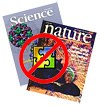 Science is revolting! A revolution is underway and the battles are taking place on the Microsoft Office frontline. Science, the journal of the America Association for the Advancement of Science (AAAS), is ditching support for Microsoft format office documents. In its notice to authors it advises that:
Science is revolting! A revolution is underway and the battles are taking place on the Microsoft Office frontline. Science, the journal of the America Association for the Advancement of Science (AAAS), is ditching support for Microsoft format office documents. In its notice to authors it advises that:
“Because of changes Microsoft has made in its recent Word release that are incompatible with our internal workflow, which was built around previous versions of the software, Science cannot at present accept any files in the new .docx format produced through Microsoft Word 2007, either for initial submission or for revision. Users of this release of Word should convert these files to a format compatible with Word 2003 or Word for Macintosh 2004 (or, for initial submission, to a PDF file) before submitting to Science.”
There is also a warning that Microsoft Word 2007 is no longer acceptable in revision documents because of problems with incompatibilities with Equation Editor.
But, it is not just hefty Science magazine, Nature has also weighed into the battle:
“We currently cannot accept files saved in Microsoft Office 2007 formats. Equations and special characters (for example, Greek letters) cannot be edited and are incompatible with Nature’s own editing and typesetting programs.”
Thanks to An Antic Disposition for bringing the S and N issues to our attention. But, is this the only evidence of a rebellion? Certainly not. While Science and Nature are ditching the various Microsoft proprietary formats for technical reasons but staff and students at Imperial College London are truly up in arms over the imposition their institution makes on them to use Microsoft products.
The Software Freedom for Imperial College is hoping to persuade IC to implement a college-wide policy that ensures students are not coerced into purchasing M$ products in order to complete their studies. At present, many tutors and professors ask for Word format files, Powerpoint presentations, and Excel spreadsheets. All of which are infinitely more expensive than the Open Source equivalents of these Office products which are widely available and widely accepted in many quarters.
The movement also hopes to discourage the use of Microsoft products for email attachments and to preclude Microsoft’s awful winmail.dat (workaround here). They want IC to ensure that all web services are standards-compliant and fully functional in all major web browsers, not just the dreaded IE. And finally, they want to see the use of free and open source software for services when high quality and reliable alternatives exist.
Several top universities have already made the move to OS and ditched Microsoft either completely or partially. In fact, IC is the only one of the Top 20 academic centres of excellence around the world that still uses a proprietary web server that is not 100% standards compliant. This resulted, according to the site in 313 errors during testing compared to University of Cambridge: 0, University of Oxford: 0, MIT: 0, and Yale University: 1 error. SFIC hopes to negotiate with IC to rectify the problems. The main issue is probably inertia, even within academic science, Word, Powerpoint, Internet Explorer, Outlook, are all considered pretty much standard the world over.
There are viable and better, free alternatives to almost all Microsoft products, such as Thunderbird email, Firefox, Safari, and Opera web browsers, OpenOffice etc etc as well as countless non-proprietary server systems.
 Berkeley nuclear chemist Mitch André Garcia is very much a modern chemist. He is not content with the staid old laboratory notebook and blotchy ballpoint in his labcoat. No! Garcia is a web-chemist.
Berkeley nuclear chemist Mitch André Garcia is very much a modern chemist. He is not content with the staid old laboratory notebook and blotchy ballpoint in his labcoat. No! Garcia is a web-chemist. Different social media, such as wikis, MySpace, Flickr, and various forums have different ways for people to give and receive gifts, according to Swedish scientists.
Different social media, such as wikis, MySpace, Flickr, and various forums have different ways for people to give and receive gifts, according to Swedish scientists. According to the UK’s Energy Savings Trust we have at least 12 gadgets on standby or recharging at any one time, including TVs, mobile phones, mp3 players, which adds up to a cost of about 40 pounds ($80) a year on domestic electricity bills. There is a strong call from environmental lobbyists for us to power down our electrical devices and now John Clare, outgoing head of one of the UK’s biggest high street electrical retailers, is calling on manufacturers to eradicate the “standby” button from devices such as DVD players and TVs.
According to the UK’s Energy Savings Trust we have at least 12 gadgets on standby or recharging at any one time, including TVs, mobile phones, mp3 players, which adds up to a cost of about 40 pounds ($80) a year on domestic electricity bills. There is a strong call from environmental lobbyists for us to power down our electrical devices and now John Clare, outgoing head of one of the UK’s biggest high street electrical retailers, is calling on manufacturers to eradicate the “standby” button from devices such as DVD players and TVs. Science is revolting! A revolution is underway and the battles are taking place on the Microsoft Office frontline. Science, the journal of the America Association for the Advancement of Science (AAAS), is ditching support for Microsoft format office documents. In its notice to authors it advises that:
Science is revolting! A revolution is underway and the battles are taking place on the Microsoft Office frontline. Science, the journal of the America Association for the Advancement of Science (AAAS), is ditching support for Microsoft format office documents. In its notice to authors it advises that: The latest issue of my Spotlight column for the science search and tutorials portal Intute is now online. In it I report on:
The latest issue of my Spotlight column for the science search and tutorials portal Intute is now online. In it I report on: